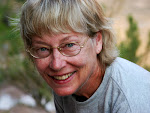 |
| Pancake ice on the River Dee Photo by Jamie Urquhart, biologist from here |
How does such ice form? To start with, we probably need to review a phenomenon known as "frazil ice." Water normally freezes at 273.15 K (32 F), but can be supercooled down to almost 231 K if there are no nuclei for the ice crystals (that is, the water needs to be very pure). Frazil ice forms in turbulent, slightly supercooled water. It consists of small discs of ice 1-4 millimeters in diameter and 1-100 microns in thickness. It is estimated that sometimes there can be one million ice crystals in a cubic meter of water. As the crystals grow, they will stick to objects in the water and tend to accumulate on the upstream side of objects. This can cause ice dams and serious flooding.
According to the CNN article referenced in the figure caption, there have been some cold nights in Scotland. They speculate that the disks form at night (and are round because they form in swirling eddies), soften in the daytime so that the rims get pushed up by collisions, and then grow further the next night, etc. Pancake ice is a well understood phenomenon on the oceans.







No comments:
Post a Comment